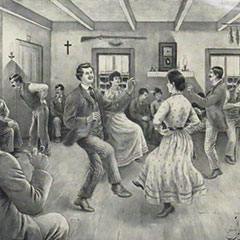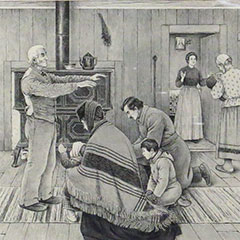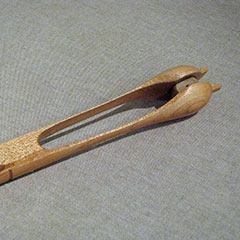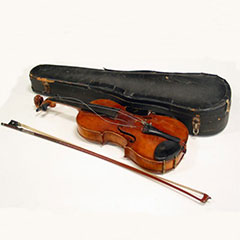Happy New Year!
Traditions surrounding the festive New Year’s period stretch from December 31st to the whole month of January. In the beginning, mostly, they are centred on religious ceremonies among which New Year’s Mass and the father’s blessing are the main events. It is also an occasion to get together as a family, to celebrate the year’s beginning by an exchange of gifts, plenty of good food and traditional music to dance the whole night through.
January 1st is seen as the first day of the year since the middle of the 16th century. It seems that, in North America, New Year’s has been celebrated since the arrival of the first settlers. Until very recently, traditions have remained similar in every Québec family. Festivities revolve around the religious rites, family reunions, and the exchange of greetings.
Prior to the 1970s, at a time where most Québécois still practise the Catholic religion, January 1st starts off with the whole family attending Mass. Receiving communion on the first day of the year is supposed to bring luck. People dressed in new clothes to avoid sickness. Gifts are exchanged before lunch, after which visits to relatives take place until dinnertime, when the entire family is reunited for a great New Year’s meal. The evening festivities go on until the wee hours, with card games and dancing.
Nowadays, wishes for a happy New Year are exchanged starting at midnight on December 31st. A standard formula is often heard, calling for good health, success in one’s studies, luck in love and a prosperous future. The good spirit lasts throughout the month of January.
Since the 1970s, watching year-end specials on television is becoming a new tradition. In Québec, the classic Bye Bye – a comic review of the year’s events – first broadcast in 1968 is often the most watched show of the season.
Songs of the New Year
The festive season is just perfect for gatherings and parties, and New Year’s songs are ideal in this respect. Many of the lively songs on this theme come from traditional folklore. Even those that were composed more recently maintain similar inspirations. They talk about festivities and feasts, and the music keeps the cadenced pace typical of Québec dance parties.
The song Le jour de l’An (New Year’s Day) by La Bolduc illustrates the atmosphere of a traditional New Year’s evening and also of the preparation that precedes it. The popular chorus translates as:
It’s New Year’s
Let’s hold hands and kiss
Let’s make the most of it
‘Cause it happens only once a year
Le jour de l’an (New Year's Day)
Download audio (3 minutes 08 seconds, 2.88 MB)
Female voice (La Bolduc) singing Le jour de l'an accompanied by violin.
Performer: La Bolduc, 1930
Source: BAnQ – Digital collection [sound recordings]
I'll cook some good meat pie, some good old times stew
On New Year's Day, let's hold hands, let's kiss
It's a good time to celebrate, it happens just once a year
Paint your cutter, go shoe your mare
We'll go see your sister way down the fifth range
On New Year's Day, let's hold hands, let's kiss
It's a good time to celebrate, it happens just once a year
Go buy a wig, get some teeth
You just got me to flirt with, but you'd be cuter
On New Year's Day, let's hold hands, let's kiss
It's a good time to celebrate, it happens just once a year
Remember to tell your Uncle Nazaire to be there on New Year's Day
Show him your moves, how you danced when you were young
On New Year's Day, let's hold hands, let's kiss
It's a good time to celebrate, it happens just once a year
Don't lose your head like two years ago
You started sobering up when you had no more money
On New Year's Day, let's hold hands, let's kiss
It's a good time to celebrate, it happens just once a year
Some of us will have a drink and enjoy these times
Today, life is costly, everyone works
On New Year's Day, let's hold hands, let's kiss
It's a good time to celebrate, it happens just once a year
Some smell of pipe and some smell of onions
I'll tell you right now, most smell of booze
On New Year's Day, let's hold hands, let's kiss
It's a good time to celebrate, it happens just once a year
The song La parenté (The Relatives) popularized by Jacques Labrecque recalls all the visits made of New Year’s Day, just as the first verse indicates « Relatives came to visit us just like on New Year’s Day ». Jacques Labrecque is also the interpreter of another holiday hit, all about young people socializing during that time of year.
That’s how things happen during the holidays
“Tape la galette”, boys and girls alike*
That’s how things happen during the holidays
That’s how things happen on New Year’s Day
*Note: The meaning of the expression “tape la galette” is unclear. Some believe it refers to an old saying meaning to throw up, more specifically in relation to drinking and partying. Others feel it recalls a type of dance accompanied by a drum, and note that the verse probably has a hidden sexual meaning as well.
La bénédiction (The Blessing)
Download audio (3 minutes 17 seconds, 3.01 MB)
Male voice (Albert Viau) singing La bénédiction accompanied by stringed instruments.
Composers: Deprès Levy–Gustave Goublier
Harmonisation: Van de Goor
Performer: Albert Viau,1941
Source: BAnQ – Digital collection [sound recordings]
At the foot of the Cross, fell to its knees!
The father arises after the prayer.
Here's what he says in a serious and gentle tone
"Blood of my blood, son of my kin,
All here today under my Roof!
Of your elders you follow the steps,
And remain guardians of the Faith,
Safeguard the traditions
Once bequeathed by our elders!
Protect first our language,
Our melodious speech!
Of our beloved land, Canada
Be the proud defenders
If our country is attacked
Stand up against the aggressor
My head touches the ground
My time is over
Think of me in your prayers
Go children, with my blessings!"
The Neo-Trad Trend
Traditional songs have not been left aside in our modern times; they have been transformed. One example of this is the song Mon Joe, a traditional piece reinvented by Paul Piché:
Today is New Year’s Day
My friend Joe Malurette
Today is New Year’s Day
Time to change mistresses
The craze for music inspired by the traditional repertoire, also called neo-trad music, emerged in the 1990s. Bands composed new songs with a traditional flair and interpreted songs taken directly from the folklore. In Québec, groups such as La Bottine souriante, Mes Aïeux, La Volée d’castors, Les Batinses, Swing, and many others delight the growing number of fans of these festive and rallying rhythms.
Neo Traditional Music
Download video: MP4, (34,08 MB), WebM, (35,69 MB), Ogg (32,68 MB) (2 minutes 53 seconds)
Interview with Sébastien Deshaies, Musician and Teacher at the Collège Notre Dame de- l'Assomption of Nicolet, about neo-traditional music.
Interview with Sébastien Deshaies
But as far as music goes it's not the case at all, we really were influenced by the British. Imagine that you are in the nineteenth century and that you are organizing a dance evening, then you obviously invite dancers and a fiddler, who was in fact standing up on a table to see the dancers. A fiddler actually plays the violin, but he's also doing some podorhythmia (foot taping), and it's something particular we do here in Québec. Here is an example of what podorhythmia is [demonstration of sounds produced when tapping your feet on the ground or on a board].
A little bit later, it was the twentieth century and we added some new instruments, instruments like the piano or the accordion. But hey, we get to the 1930s for example, and then jazz has a big influence, jazz swing from the 1930s. So pianists have greatly influenced the accompaniment part of the "trad" music.
Today, when we talk about neo-traditional music, "neo-trad" as we often like to call it, well we talk in fact about a product that was influenced by many, many, many things. What is interesting to see is that we adapt our folklore to other musical styles. It may be, for example, music that comes from Africa or any other culture in the world. Music that we will borrow and make our own. Of course we will integrate aspects from our culture, like foot tapping. By keeping the violin or accordion for example, we will know that it is still our traditional Québec music. It's just like the tree analogy: a tree has deep roots, and then eventually grows with branches going left and right that sometimes take unusual shapes. It's the way I see the evolution of "neo-trad" music.
Sébastien Deshaies, Musician
Teacher at the Collège Notre-Dame-de-l'Assomption of Nicolet
Technical Team:
David Leblanc: Director/Cameraman/Editor
Jonathan Leblanc: Technician
Acknowledgement
Conservatoire de musique de Trois-Rivières
Foot Tapping
Download video: MP4, (12,51 MB), WebM, (13,38 MB), Ogg (10,08 MB) (1 minute 10 seconds)
Interview with Sébastien Deshaies, Musician and Teacher at the Collège Notre-Dame-de-l'Assomption of Nicolet, about foot tapping.
Interview with Sébastien Deshaies
Sébastien Deshaies, Musician
Teacher at the Collège Notre-Dame-de-l'Assomption of Nicolet
Technical Team:
David Leblanc: Director/Cameraman/Editor
Jonathan Leblanc: Technician
Acknowledgement
Conservatoire de musique de Trois-Rivières








